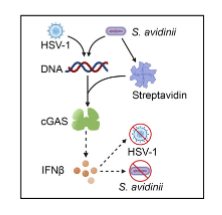Hyperactivation of innate immunity results in autoimmune diseases, while deficiency in innate immunity is prone to tumorigenesis. Thus, the activity of innate immune signaling is tightly controlled but the regulatory mechanisms have not been fully elucidated. Recently, the labs of Liu and Damania published a study in iScience revealing a role of the bacterial protein streptavidin in binding and facilitating cGAS activation.
Humans utilize two layers of defense systems to fight against viral or bacterial infection, namely innate immunity (non-specific) and adaptive immunity (specific). Innate immunity is the first layer of host defense triggered by invading foreign materials including nucleotides (DNA and RNA). cGAS (cGAMP synthase) was determined in 2013 as the major cytosolic DNA sensor to trigger innate immunity for clearance of infection and transduction of signals to activate adaptive immunity. One mechanism to regulate cGAS activity is through its binding partners and indeed mammalian proteins and viral proteins have been identified to bind and modulate cGAS activity. It remains largely unclear if bacterial protein(s) also participates into cGAS activity control.
Work led by a previous postdoc Dr. Yanqiong Zhang in Liu lab, Dr. Zhe Ma in Damania lab and Ying Wang, a Molecular & Cellular Biophysics graduate student, in Liu lab surprisingly found streptavidin, a secreted bacterial protein by Streptomyces Avidinii, that is widely used in labs to pulldown biotin labeled biological materials and as a key component for drug delivery vehicles, specifically bound to cGAS proteins in vitro with a Kd of ~1.2 uM. Using cell culture system, they found streptavidin expression facilitated cGAS activation induced by DNA, leading to increased interferon production. Mechanistically, streptavidin enhances DNA binding to cGAS that promotes cGAS phase separation, a key step for cGAS activation. Further, in mouse models, they found HSV-1 (a DNA virus) infection induced innate immune activation was further enhanced by either recombinant streptavidin proteins or streptavidin coated nanoparticles in WT but not cGAS-/- mice, resulting in better clearance of infected HSV-1 viruses.

 This work reveals a new cGAS activity regulatory mechanism by a bacterial protein that is used in labs and clinic. They further found that streptavidin fluoroprobes used to monitor cellular localization of biotin-tagged DNA/protein could detect endogenous cytosolic cGAS signals. These findings suggest that caution need to be taken into consideration in these streptavidin-mediated applications due to the additional ability of streptavidin to induce innate immunity through binding cGAS.
This work reveals a new cGAS activity regulatory mechanism by a bacterial protein that is used in labs and clinic. They further found that streptavidin fluoroprobes used to monitor cellular localization of biotin-tagged DNA/protein could detect endogenous cytosolic cGAS signals. These findings suggest that caution need to be taken into consideration in these streptavidin-mediated applications due to the additional ability of streptavidin to induce innate immunity through binding cGAS.
Other co-authors include Joshua Boyer from Qi Zhang lab, Guoxin Ni and Zhigang Zhang from Blossom Damania lab, Liang Cheng from Lishan Su lab, and Siyuan Su, Zhichuan Zhu and Jiayi Qian from Pengda Liu Lab.
Check out their work here:
Zhang, Y., Ma, Z., W, Y., Boyer, J., Ni, G., Cheng, L., Su, S., Zhang, Z., Zhu, Z., Qian, J., Su, L., Zhang, Q., Damania, B., and Liu, P. Streptavidin promotes DNA binding and activation of cGAS to enhance innate immunity. iScience (2020).
